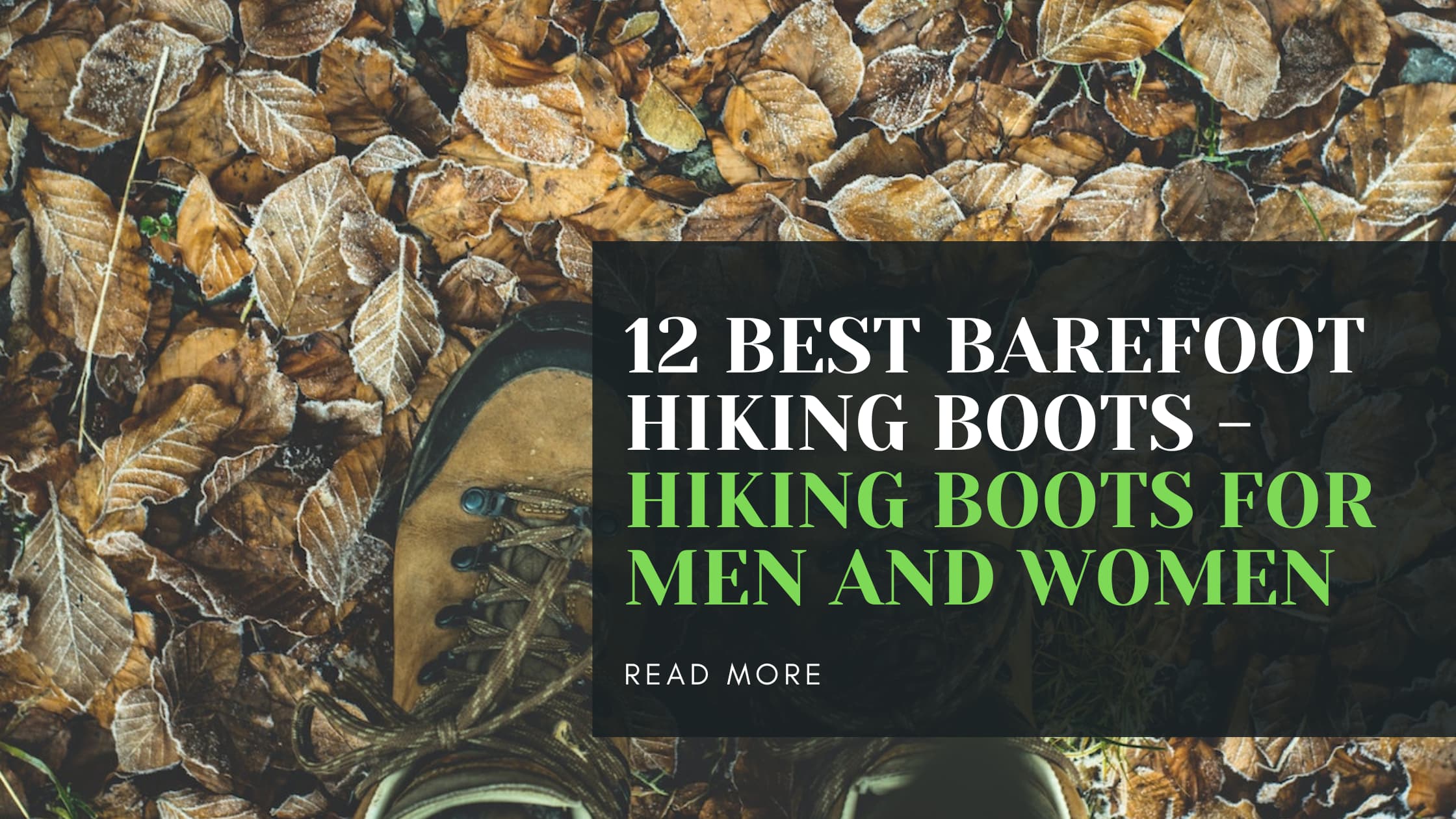Barefoot Hiking Boots is becoming more and more popular as people discover the benefits of natural footwear. Barefoot boots allow your feet to move and flex naturally, while still providing protection from the elements when you’re out on the trail.
In this complete guide, we’ll cover everything you need to know about barefoot hiking boots, including:
- What are barefoot hiking boots?
- Benefits of barefoot hiking boots
- What to look for when choosing barefoot hiking boots
- Reviews of the top barefoot hiking boot brands
- FAQs about barefoot hiking boots
What are Barefoot Hiking Boots?
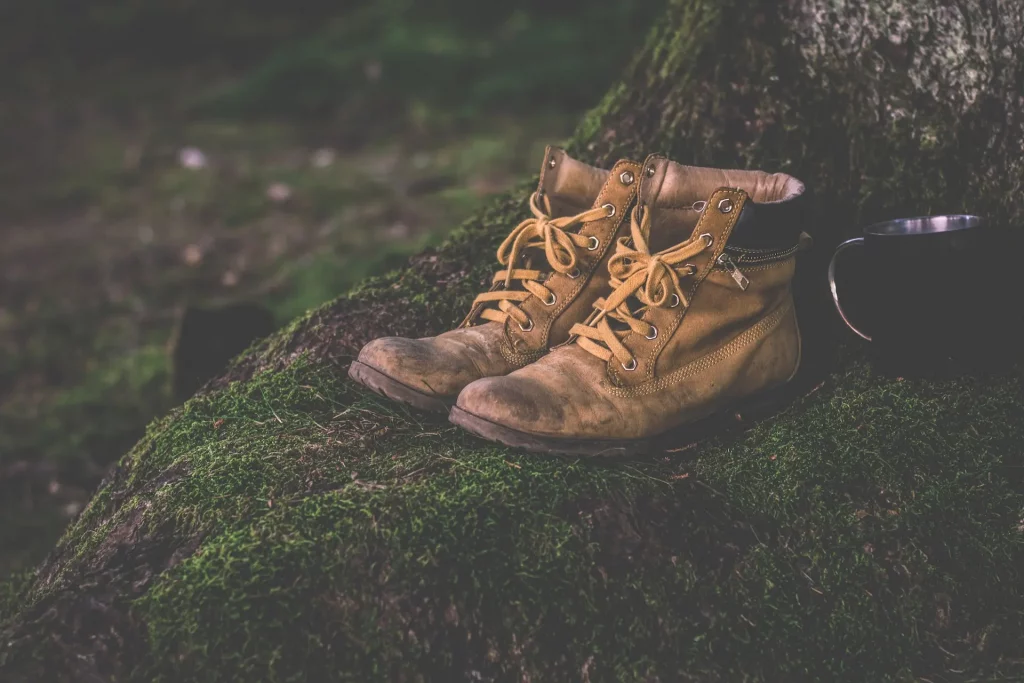
Barefoot hiking boots are much different than traditional hiking boots in a few key ways:
- Wide toe box – Barefoot boots are shaped like actual feet with a wide toe box to allow toes to splay naturally. This prevents bunions and other foot issues caused by narrow shoes.
- Zero drop – The heels and toes of barefoot boots are at the same level, like if you were standing barefoot. Traditional boots have elevated heels which put a strain on feet.
- Thin, flexible soles – Barefoot boot soles are thin and flexible to maximize ground feel and allow your feet to move naturally. Many traditional boots have thick, rigid soles.
Some key pros of barefoot hiking boots compared to traditional boots:
- Improve stability and balance
- Allow natural foot flexing and strength
- Reduce joint strain from elevated heels
And some cons to consider:
- Less weather protection and insulation
- Require gradual transition to avoid injury
- Lack ankle support some hikers prefer
So in summary, barefoot hiking boots combine the protection of a hiking boot upper with the benefits of a natural, barefoot-style sole.
Benefits of Barefoot Hiking Boots
Switching to barefoot hiking boots can provide a number of benefits:
- Improved stability – Allowing your feet to flex and move naturally improves balance and stability on uneven trails.
- Stronger feet – Barefoot boots help build strength in foot muscles and tendons since your feet get to move and work naturally.
- Proper toe alignment – Wide toe boxes allow toes to splay and stay aligned instead of being squeezed into a narrow shape that can cause bunions and other issues.
- Better posture – Zero drop soles encourage better posture and spinal alignment compared to shoes with elevated heels.
- Increased ground feel – Thin, flexible soles maximize sensory feedback from the ground for better balance and agility.
- Reduced injury risk – Barefoot boots reduce stress on feet, ankles, and knees compared to stiff traditional boots.
What to Look for in Barefoot Hiking Boots
When shopping for barefoot hiking boots, keep an eye out for these key features:
- Toe box shape – Ensure the toe box is wide and anatomically shaped to allow natural toe splay.
- Zero drop platform – The boot should not have an elevated or contoured heel.
- Sole thickness – Look for relatively thin and flexible soles under 5mm. Some boots may have slightly thicker soles for durability and cold weather.
- Weight – Look for lightweight materials in the uppers and soles to keep boots under 2 lb per shoe for versatile hiking.
- Break-in time – Quality leathers or synthetic materials should break in within a few weeks. Avoid stiff, heavy boots that need months to break in.
- Upper material – For lightweight boots focus on breathable meshes and knits. For weatherproofing look for treated leather or waterproof linings.
- Lug depth – Look for at least 3-4mm deep lugs for traction in mud and loose terrain. Deeper lugs provide more traction but reduce ground feel.
- Removable insole – Removable insoles allow you to control cushioning and accommodate orthotics if needed.
- Vegan options – Many brands offer animal-free barefoot boots. Look for microfiber leather substitutes and recycled materials.
- Price – Expect to pay $100 – $250 for most quality barefoot hiking boots. Some premium handmade options can run $300+
Reviews of the Top Barefoot Hiking Boot Brands
Vivobarefoot Hiking Boots
Vivobarefoot makes some of the most popular barefoot hiking boots with different models to suit any condition.
Vivobarefoot Tracker FG
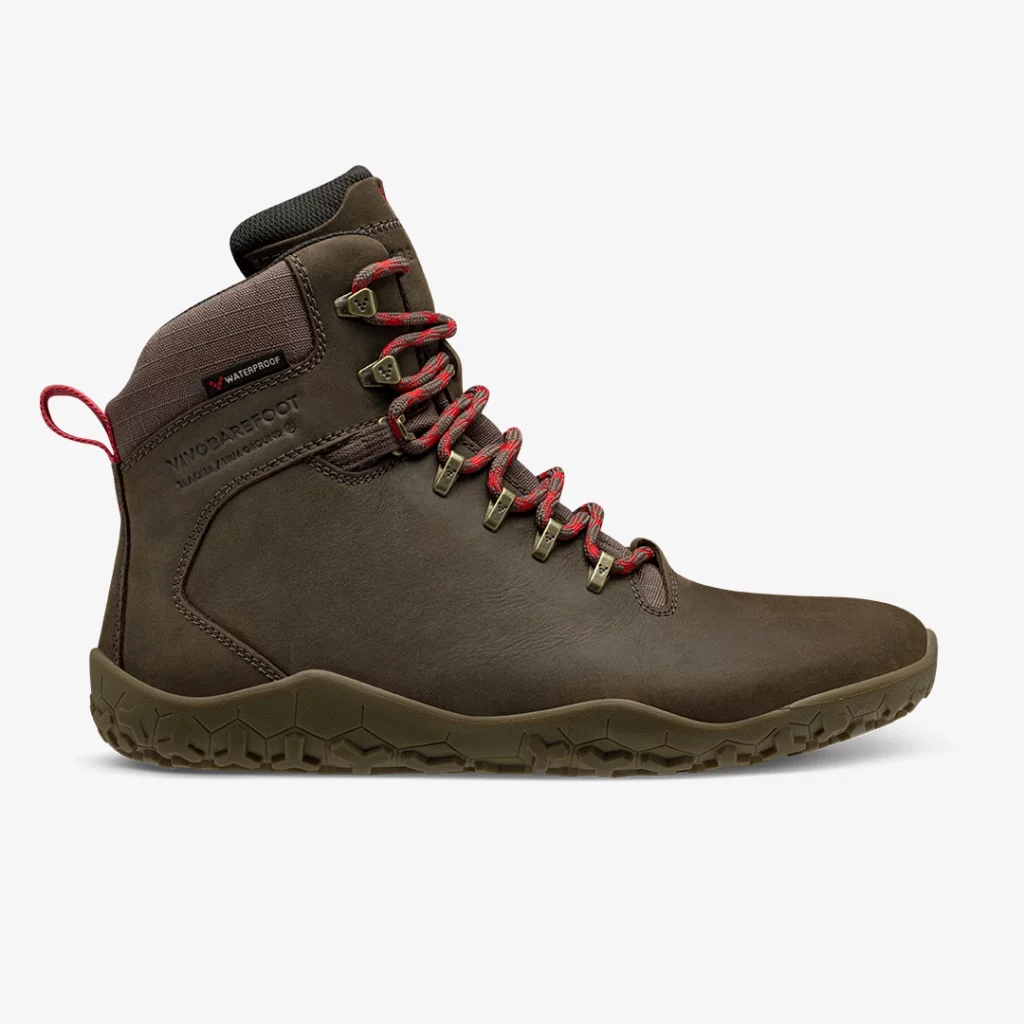
Shop now:https://www.vivobarefoot.com/us/tracker-ii-fg-mens-ss22
The Vivobarefoot Tracker FG is a fully waterproof barefoot hiking boot. Key features:
- Waterproof oiled leather upper
- Lug depths up to 5mm for traction
- Removable thermal insole for warmth
- Vegan options not available
Vivobarefoot Magna Trail Outdoor
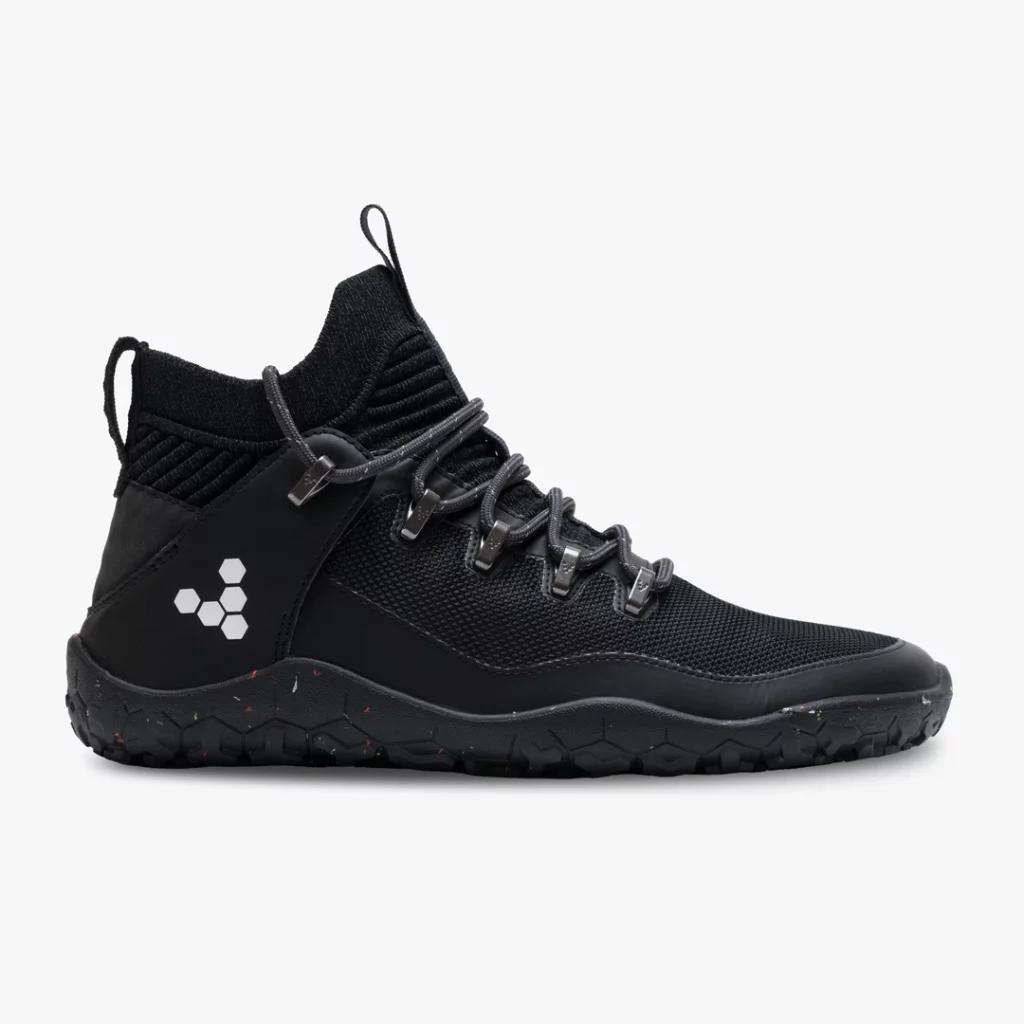
Shop now: https://www.vivobarefoot.com/us/magna-trail-ii-fg-womens-ss23
The Magna Trail is a lightweight, flexible barefoot hiker. Key features:
- Breathable air mesh upper
- 3mm Vibram outsole
- Vegan-friendly materials
- Not waterproof
Vivobarefoot Tracker Forest ESC
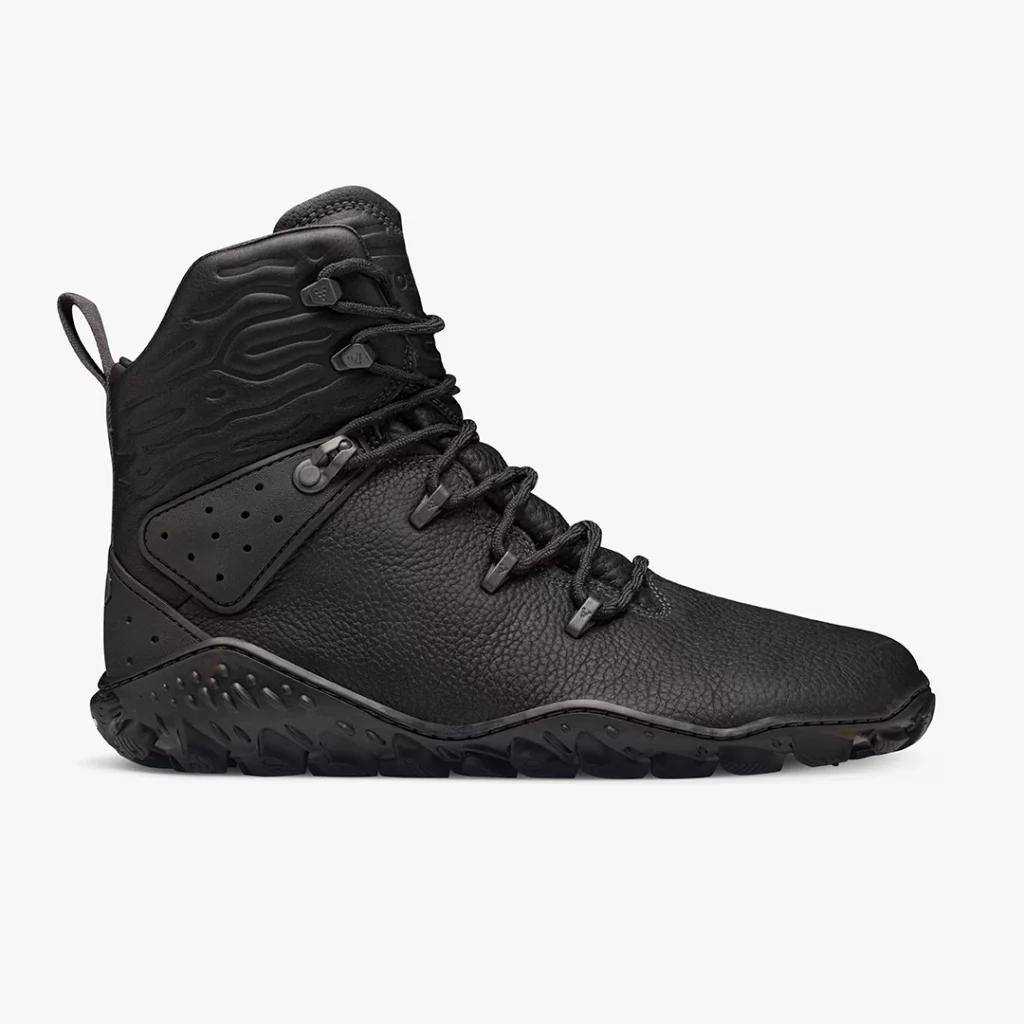
Shop now: https://www.vivobarefoot.com/us/tracker-forest-esc-mens-aw22
The Tracker Forest ESC prioritizes grip and rough terrain traction. Key features:
- Water-resistant suede upper
- Deep 6mm lugs for traction
- Firm ground outsole for stability
Xero Shoes Hiking Boots
Xero Shoes make minimalist hiking boots with extra comfort features.
Xero Shoes DayLite Hiker
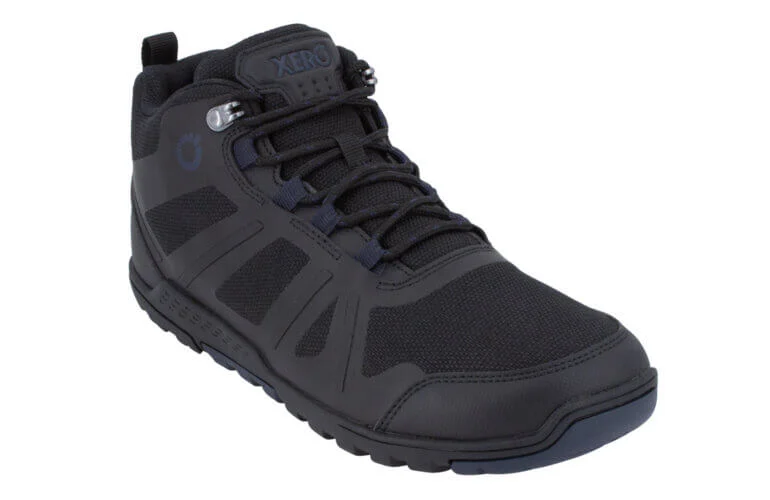
Shop now:https://xeroshoes.com/shop/boots/dlh-men/
The DayLite Hiker is Xero’s most lightweight and flexible hiking boot. Key features:
- Mesh upper for breathability
- 5.5mm FeelTrue rubber sole
- Vegan-friendly materials
- Not waterproof
Xero Shoes Mesa Trail
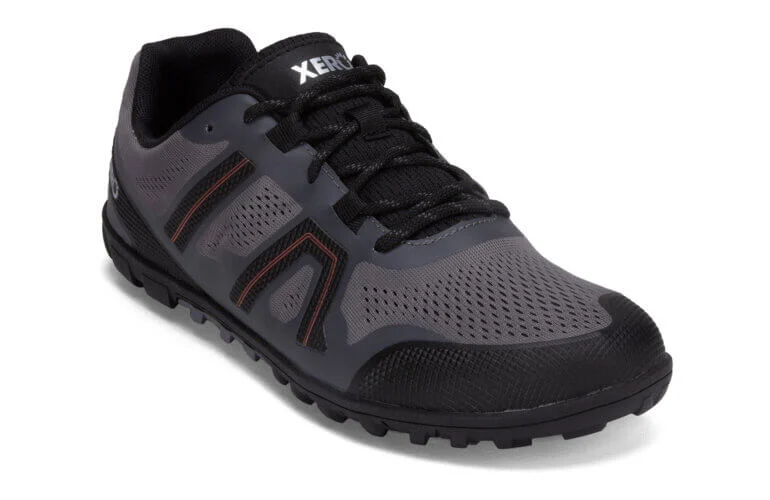
Shop now:https://xeroshoes.com/shop/shoes/mesa-trail-men/
The Mesa Trail offers weather protection with more comfort. Key features:
- Water-resistant leather or textile uppers
- 5.5mm sole with 3.5mm lugs
- Removable foam insole for comfort
Xero Shoes Alpine

Shop now:https://xeroshoes.com/shop/boots/alpine-men/
The Alpine is Xero’s warmest and most weatherproof hiking boot. Key features:
- Waterproof leather upper with faux fur lining
- 9mm Vibram sole for thermal insulation
- Removable heat-moldable insole
Freet Footwear Hiking Boots
Freet makes vegan barefoot hiking boots with innovative sustainable materials.
Freet Mudee
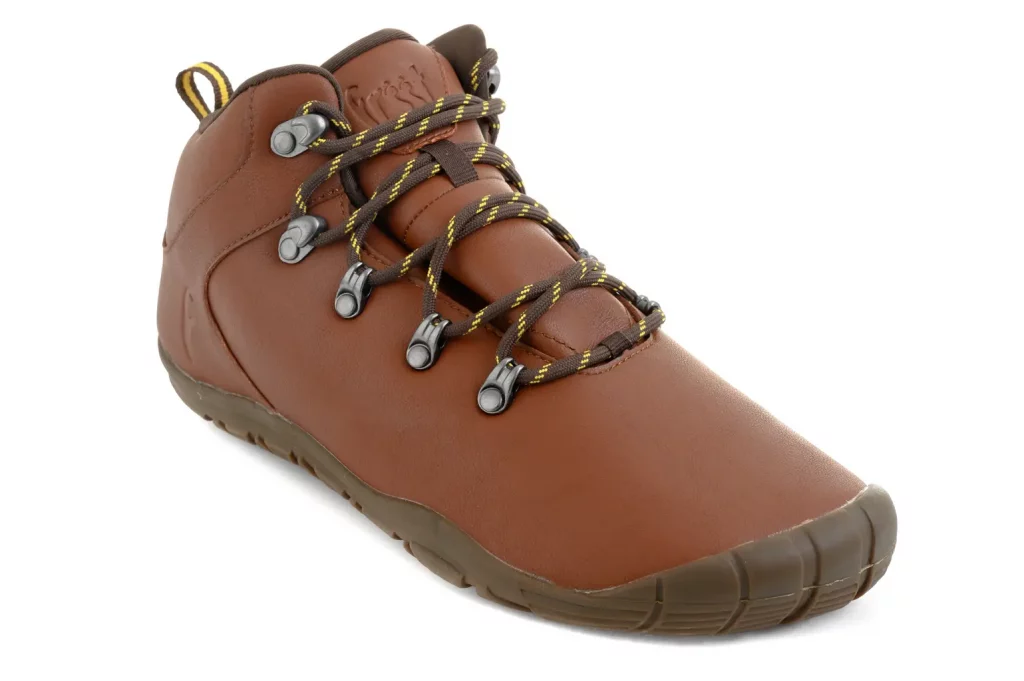
Shop now:https://freetbarefoot.com/usa/product/mudee/
The Mudee is a water-resistant barefoot hiker. Key features:
- Hydrophobic microfiber upper sheds water
- 4mm Freet sole with 3mm lugs
- Vegan materials including coffee ground fabric
Freet Kidepo
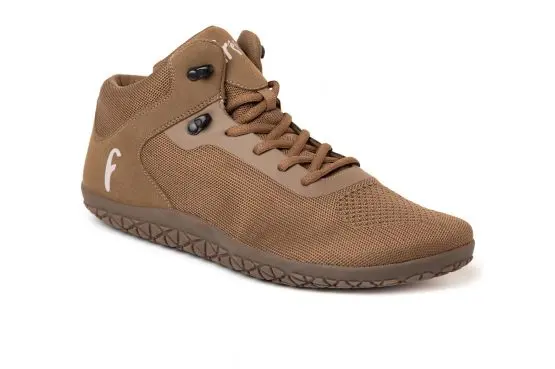
Shop now:https://freetbarefoot.com/product/freet-kidepo/
The Kidepo is an ultra-breathable barefoot hiker. Key features:
- Mesh upper made from recycled coffee grounds
- 4mm Freet sole
- Vegan-friendly materials
- Not waterproof
Lems Shoes Hiking Boots
Lems offers barefoot hiking boots with extra cushioning and protection.
Lems Boulder Boot
The original Boulder Boot is great for light hiking. Key features:
- Leather or nylon upper options
- 9mm cushioned rubber sole
- Vegan boots available
Lems Boulder Boot Mid
The mid version adds ankle support and weather protection. Key features:
- Water-resistant nylon upper
- 9mm sole with 4mm lugs
- Padded collar for comfort
Lems Boulder Boot Summit
The Summit version has enhanced traction and insulation. Key features:
- Waterproof oiled leather upper
- 16mm sole with 4mm lugs for traction
- Removable foam insole for warmth and comfort
Softstar Shoes Hiking Boots
Softstar makes handmade leather barefoot hiking boots with excellent quality and durability.
Softstar Switchback
The Switchback is Softstar’s rugged backcountry barefoot hiker. Key features:
- Water-resistant leather upper
- 9.5mm Vibram sole with deep lugs
- Removable merino wool insole
- Not vegan friendly
Budget-Friendly Options
If premium prices don’t work for your budget, check out these more affordable barefoot hiking boots:
- Ahinsa Shoes – Vegan boots under $150
- Freet Footwear – Models under $130
- Whitin – Wide minimalist boots under $100
FAQs About Barefoot Hiking Boots
Are barefoot hiking boots warm enough for winter?
Many barefoot hiking boots are lined or insulated to keep feet warm in cold weather. Look for full waterproofing and removable insoles you can swap out for warmer options like sheepskin or wool. Thicker soles also provide more insulation from the cold ground.
How long does it take to break in barefoot hiking boots?
Barefoot boot materials are naturally flexible and should not require an extensive break-in period like stiff traditional boots. However, some leather and waterproofed models may take a few weeks to soften up and mold to your feet.
Can you resole barefoot hiking boots?
Resoling depends on the construction method. Many boots with stitched soles can be resoled while glued soles cannot. Look for boots like Softstar that specifically mention resoling as an option to extend the life of your boots.
What is the best barefoot hiking boot for wide feet?
Lems, Softstar, and Altra tend to offer the widest toe box options to accommodate wide feet. Scarpa and Topo Athletic also make hiking boots with wider toe boxes. For maximum space, look for footwear labelled as “wide” or with foot-shaped dimensions listed.
How do you waterproof barefoot hiking boots?
Look for boots made with waterproof leather or with waterproof linings. You can also treat leather boots with a waterproofing wax or spray. If your boots get wet, stuff with newspaper and let them dry out slowly to maintain waterproofing.
Get Out There in Your Barefoot Boots!
Hopefully, this guide gave you all the details you need to confidently choose an awesome pair of barefoot hiking boots!
With quality barefoot boots that protect your feet while allowing natural motion, you can comfortably hike longer distances and more challenging trails. Don’t miss out on the joint benefits and improved stability you get from proper toe splay and zero-drop soles.
The brands we reviewed offer barefoot hikers for all conditions – from lightweight trail runners to ice climbing boots and everything in between. Look for the features that align with the environment you’ll use them in most and opt for a flexible sole with ample ground feel to get the most benefits.
Now that you’re ready to make the switch to natural footwear, it’s time to get out there on the trails and see how much better your feet feel after hiking in barefoot boots! Check out some hidden gems in your local area or plan your next big outdoor adventure. Where will your barefoot boots take you?
Let us know in the comments if you found this guide to barefoot hiking boots helpful! Share it with fellow outdoor enthusiasts so they can discover the benefits too.
Read more:https://worldvisitguider.com/ocean-eden-bay/

